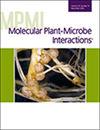Reinaldo Rodrigues de Souza-Neto, Lídia Nascimento Cavalcante, Isis Gabriela Barbosa Carvalho, Maiara Curtolo, Celso Eduardo Benedetti, Marco Aurélio Takita, Nian Wang, Alessandra Alves de Souza
求助PDF
{"title":"CRISPR/Cas9-Mediated Disruption of <i>CsLIEXP1</i> Reveals Expansin as a Key Susceptibility Factor for Citrus Canker Disease.","authors":"Reinaldo Rodrigues de Souza-Neto, Lídia Nascimento Cavalcante, Isis Gabriela Barbosa Carvalho, Maiara Curtolo, Celso Eduardo Benedetti, Marco Aurélio Takita, Nian Wang, Alessandra Alves de Souza","doi":"10.1094/MPMI-12-24-0151-R","DOIUrl":null,"url":null,"abstract":"<p><p>The <i>Citrus sinensis LATERAL ORGAN BOUNDERIES 1</i> (<i>CsLOB1</i>) gene, which is directly induced by the <i>Xanthomonas citri</i> subsp. <i>citri</i> effector PthA4, functions as a transcription factor and citrus canker susceptibility (S) gene. Genome editing of <i>CsLOB1</i> has been shown to confer resistance to citrus canker disease. Previous studies revealed that the citrus <i>CsLOB1-INDUCED EXPANSIN 1</i> gene (<i>CsLIEXP1</i>) is highly and directly upregulated by <i>CsLOB1</i> in <i>Xanthomonas citri</i> subsp. <i>citri</i>-infected plants. Because expansins are associated with cell wall loosening, potentially facilitating bacterial colonization, the <i>CsLOB1-</i>dependent activation of <i>CsLIEXP1</i> is thought to contribute to canker symptoms and disease progression. Thus, <i>CsLIEXP1</i> likely represents a critical canker susceptibility gene. In this study, we employed CRISPR/Cas9 to disrupt the function of <i>CsLIEXP1</i> by modifying its corresponding coding region in <i>Citrus sinensis</i> cultivar 'Hamlin' and evaluated the postinfection responses of edited plants. DNA sequencing confirmed the edition of the <i>CsLIEXP1</i>-edited plant, which exhibited 26.47% of <i>CsLIEXP1</i> edited sequences. Furthermore, <i>CsLIEXP1</i> protein accumulation was reduced in <i>CsLIEXP1</i>-edited plants compared with the wild type when infected with <i>X. citri</i>. Leaves of edited plants inoculated with <i>X. citri</i> showed significantly fewer canker symptoms, with lesions limited to the site of bacterial inoculation and less pronounced cellular hypertrophy compared with control plants. Our results show that <i>CsLIEXP1</i> is a citrus canker S gene that acts downstream of <i>CsLOB1</i>, thus providing new insights into plant-pathogen interactions. [Formula: see text] Copyright © 2025 The Author(s). This is an open access article distributed under the CC BY-NC-ND 4.0 International license.</p>","PeriodicalId":19009,"journal":{"name":"Molecular Plant-microbe Interactions","volume":" ","pages":"589-598"},"PeriodicalIF":3.4000,"publicationDate":"2025-07-01","publicationTypes":"Journal Article","fieldsOfStudy":null,"isOpenAccess":false,"openAccessPdf":"","citationCount":"0","resultStr":null,"platform":"Semanticscholar","paperid":null,"PeriodicalName":"Molecular Plant-microbe Interactions","FirstCategoryId":"99","ListUrlMain":"https://doi.org/10.1094/MPMI-12-24-0151-R","RegionNum":3,"RegionCategory":"生物学","ArticlePicture":[],"TitleCN":null,"AbstractTextCN":null,"PMCID":null,"EPubDate":"2025/8/7 0:00:00","PubModel":"Epub","JCR":"Q2","JCRName":"BIOCHEMISTRY & MOLECULAR BIOLOGY","Score":null,"Total":0}
引用次数: 0
引用
批量引用
Abstract
The Citrus sinensis LATERAL ORGAN BOUNDERIES 1 (CsLOB1 ) gene, which is directly induced by the Xanthomonas citri subsp. citri effector PthA4, functions as a transcription factor and citrus canker susceptibility (S) gene. Genome editing of CsLOB1 has been shown to confer resistance to citrus canker disease. Previous studies revealed that the citrus CsLOB1-INDUCED EXPANSIN 1 gene (CsLIEXP1 ) is highly and directly upregulated by CsLOB1 in Xanthomonas citri subsp. citri -infected plants. Because expansins are associated with cell wall loosening, potentially facilitating bacterial colonization, the CsLOB1- dependent activation of CsLIEXP1 is thought to contribute to canker symptoms and disease progression. Thus, CsLIEXP1 likely represents a critical canker susceptibility gene. In this study, we employed CRISPR/Cas9 to disrupt the function of CsLIEXP1 by modifying its corresponding coding region in Citrus sinensis cultivar 'Hamlin' and evaluated the postinfection responses of edited plants. DNA sequencing confirmed the edition of the CsLIEXP1 -edited plant, which exhibited 26.47% of CsLIEXP1 edited sequences. Furthermore, CsLIEXP1 protein accumulation was reduced in CsLIEXP1 -edited plants compared with the wild type when infected with X. citri . Leaves of edited plants inoculated with X. citri showed significantly fewer canker symptoms, with lesions limited to the site of bacterial inoculation and less pronounced cellular hypertrophy compared with control plants. Our results show that CsLIEXP1 is a citrus canker S gene that acts downstream of CsLOB1 , thus providing new insights into plant-pathogen interactions. [Formula: see text] Copyright © 2025 The Author(s). This is an open access article distributed under the CC BY-NC-ND 4.0 International license.
CRISPR/ cas9介导的CsLIEXP1断裂揭示扩张蛋白是柑橘溃疡病的关键易感因子
柑橘黄单胞菌(Xanthomonas citri亚种)直接诱导的柑橘侧枝器官边界1 (Citrus sinensis LATERAL ORGAN borderies 1, CsLOB1)基因。柑橘效应因子PthA4,作为柑橘溃疡病易感性(S)基因的转录因子。CsLOB1的基因组编辑已被证明可以赋予柑橘溃疡病的抵抗力。前期研究发现柑橘CsLOB1诱导的扩张素1基因(CsLIEXP1)在柑橘黄单胞菌亚种中被CsLOB1直接高表达上调。citri-infected植物。由于扩张蛋白与细胞壁松动有关,可能促进细菌定植,因此CsLIEXP1依赖于cslob1的激活被认为有助于溃疡症状和疾病进展。因此,CsLIEXP1可能代表了一个关键的溃疡病易感基因。在本研究中,我们利用CRISPR/Cas9技术,通过修改柑橘(Citrus sinensis cv’Hamlin)中CsLIEXP1对应的编码区,破坏其功能,并评估编辑后植株的感染后反应。DNA测序证实了CsLIEXP1编辑的植物版本,显示了26.47%的CsLIEXP1编辑的序列。此外,与野生型相比,CsLIEXP1编辑过的植物感染柑橘X.后,CsLIEXP1蛋白的积累减少。与对照植物相比,接种柑橘X.柑橘的编辑植物的叶子表现出明显较少的溃疡病症状,病变仅限于细菌接种部位,并且细胞肥大不那么明显。我们的研究结果表明,CsLIEXP1是一个作用于CsLOB1下游的柑橘溃疡病S基因,从而为植物与病原体的相互作用提供了新的见解。
本文章由计算机程序翻译,如有差异,请以英文原文为准。

 求助内容:
求助内容: 应助结果提醒方式:
应助结果提醒方式:


